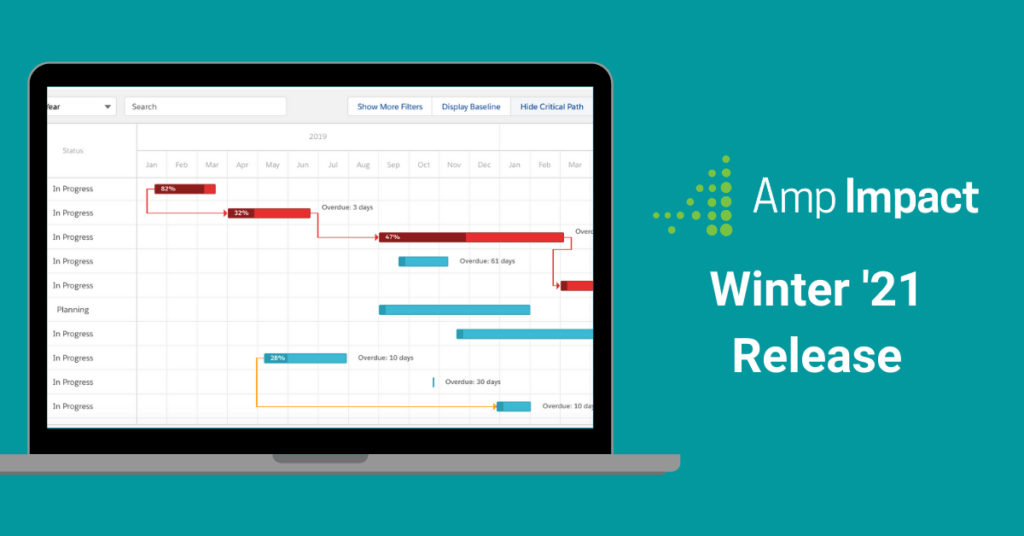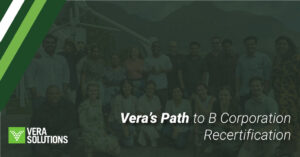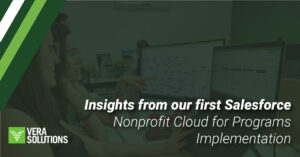Amp Impact Electra, the product’s Winter ‘21 release, brings powerful new functionality to strengthen work planning and logframe management, provides greater flexibility to use Amp Impact’s features on any Salesforce object(s), and adds key enhancements to continue strengthening the product’s user-experience.
With the Delphinus release last Summer, we unveiled Amp Impact’s new Manage Indicators page, rebuilt as a Lightning Web Component (LWC). LWCs use core Web Component standards and provide only what’s necessary to perform well in browsers supported by Salesforce. This ensures that Amp Impact remains lightweight and delivers exceptional performance for users. With the Electra release, we’re excited to announce that we’ve revamped two more key features – Logframes and Work Planning (also known as Activities) – as LWCs to further enhance page load speeds and overcome data limitations.
While the LWCs replicate much of the previous interface for Logframes and Work Planning, they enable a number of UI/UX improvements. Users can now add standard objectives from a catalog to a Framework, create multiple Frameworks within a project, and do more sophisticated project planning, with activity dependencies, drag-and-drop Gantt charting, and critical path functionality.
Additionally, Amp Impact’s features (including Frameworks, Activities, Indicators, Targets, Results, etc.) can now be used on any Salesforce object(s), not just the Amp Impact Project object. This ensures greater flexibility for our customers as well as seamless interoperability with Salesforce.org’s emerging Nonprofit Cloud suite, including the Nonprofit Success Pack, Outbound Funds Module, and Program Management Module.
Finally, Amp Impact customers can now benefit from pre-filled, ready-to-upload reference data templates to quickly get a system or sandbox loaded with relevant records, such as geographic areas, thematic areas, indicators, and objectives, from common sources like IRIS+, ISO, IATI, DFID, and the UN SDG Framework. For example, in under ten minutes, you can easily have all the regions, subregions, and countries in the world with ISO codes and GPS coordinates loaded into Amp Impact as hierarchical Geographical Areas and/or all the UN Sustainable Development Goals, Targets, and Indicators. This resource makes Amp Impact quicker and easier to set up and supports data standardization and alignment across social impact organizations.

READ BLOG: Amp Impact Delphinus launches new Grant Applications and Reviews Module
Activities and Gantt Chart Enhancements
Since we initially launched Amp Impact’s work planning features in the Winter ‘19 release, more and more organizations have started using Amp Impact as their central source of truth for project and program data. Taking customer feedback into account, we’ve now strengthened the Gantt chart functionality to facilitate dynamic work planning and activity monitoring. With the Electra release, you can now drag-and-drop Activities in your Gantt charts, track and view Activity completion as a percentage, create and manage Activity dependencies (for example, if one Activity must end before another starts), and visualize a work plan’s critical path.
Activity Dependencies
Users can now create, manage, and visualize dependencies between activities to mark whether one activity should start or finish based on the start or end of another activity. Users can add these dependencies directly in the Gantt chart by clicking on the leading activity and dragging the dependency arrow to an activity that depends on it.

Drag-and-Drop Rescheduling
In the new LWC, users can simply click on any activity in the Gantt Chart and drag it to a new place in the timeline to reschedule (or to advance or delay an activity’s start or end date).
Track Percent Completion
Mark progress for an activity by filling in the timeline bar to indicate the percent completion.
Critical Path
Visualize the critical path of an implementation plan, by tracking the set of activities that must start and finish on time in order to ensure the work plan ends on schedule.

Request a demo to see Amp Impact’s work planning functionality in action.
Manage Frameworks Enhancements, including Multiple Frameworks
A key part of Amp Impact’s impact measurement functionality is the Manage Frameworks page. This allows organizations to set up logical frameworks for projects and programs and track progress toward impact goals, connecting indicators to impacts, objectives, outcomes, outputs, and/or activities.
Now we’ve expanded logframe management functionality with a new Framework object and LWC, providing users the ability to create and manage multiple Frameworks within a project or program, easily add standard objectives to a Framework from a catalog, and manage Framework review and approval.
Multiple Frameworks
Since there may be a need to create more than one Framework within a single project record (e.g. reporting to different funders, setting up different logframes within different countries, or breaking out objectives by implementing partner), users can now create, edit, and view multiple Frameworks within the same page.

Catalog of Objectives
In earlier versions, only custom objectives could be added directly into a Framework and catalog-level objectives could only be added to a Framework through a related list or ScreenFlow. Now, the catalog of objectives is accessible directly on the Frameworks page, so that users can easily search for standard objectives and add them to a framework.





